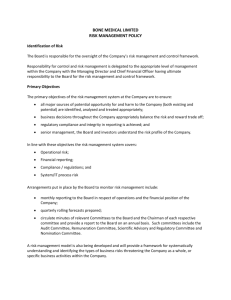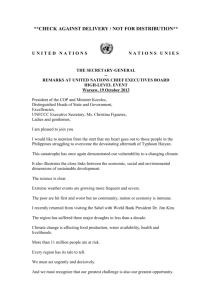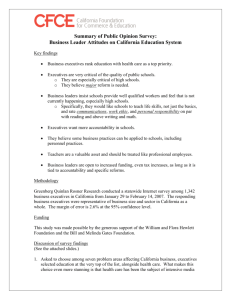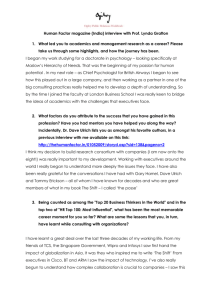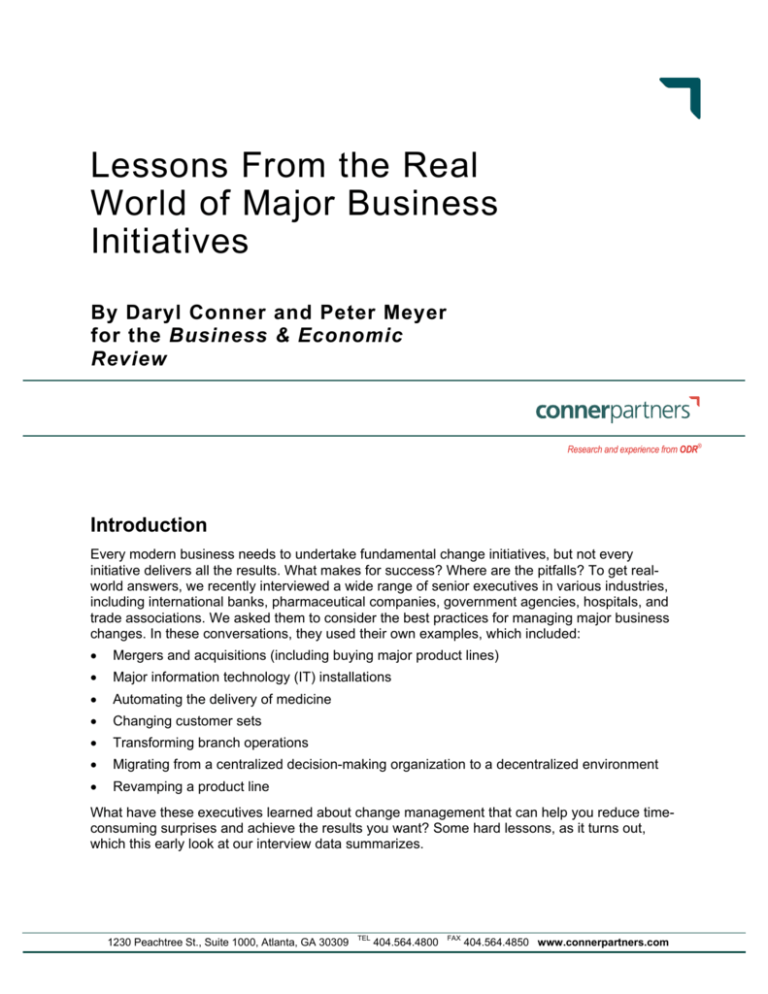
Lessons From the Real
World of Major Business
Initiatives
By Daryl Conner and Peter Meyer
for the Business & Economic
Review
®
Research and experience from ODR
Introduction
Every modern business needs to undertake fundamental change initiatives, but not every
initiative delivers all the results. What makes for success? Where are the pitfalls? To get realworld answers, we recently interviewed a wide range of senior executives in various industries,
including international banks, pharmaceutical companies, government agencies, hospitals, and
trade associations. We asked them to consider the best practices for managing major business
changes. In these conversations, they used their own examples, which included:
•
Mergers and acquisitions (including buying major product lines)
•
Major information technology (IT) installations
•
Automating the delivery of medicine
•
Changing customer sets
•
Transforming branch operations
•
Migrating from a centralized decision-making organization to a decentralized environment
•
Revamping a product line
What have these executives learned about change management that can help you reduce timeconsuming surprises and achieve the results you want? Some hard lessons, as it turns out,
which this early look at our interview data summarizes.
1230 Peachtree St., Suite 1000, Atlanta, GA 30309
TEL
404.564.4800
FAX
404.564.4850 www.connerpartners.com
Four Lessons
Many of the executives we interviewed affirm that initiatives often fail to reach their realization
potential. Their collective wisdom about how to avoid this comes down to us as four key
lessons. Think of these as warnings that must be addressed early and well:
1. Define your criteria for success in advance
2. Take an active leadership role
3. Remember that people are your greatest variable
4. Correctly estimate your capacity for change
Define Your Criteria for Success in Advance
The executives who participated in the interviews issued a warning about the real risk when
executing critical changes. What we heard was that major initiatives usually don’t “fail” outright
as much as they deliver less than the original promises. The interviews draw a clear distinction
between what we’ll call installation versus realization. Mary Anne Elliott, Executive VP of CIBC,
pointedly states that, “We need to understand up front what we’re looking for, and be very
concrete and specific about what that looks like.” Along these same lines, Robin King, Vice
President of Public Affairs at the Aluminum Association, notes that “we’ve invested in most of
what we need; now we need to use it. It’s installed, people are trained, but we are not realizing
benefits yet.”
Success is not defined merely by installing the applications, acquiring the products, or signing
the merger agreement. Success happens when you realize the benefits that caused you to
launch the initiative in the first place. The interviews provide a clear warning: Don’t be seduced
by installation success; realization of your change objectives is what you’re really after.
Clear criteria make it easier to garner support. Otto Salguero, Vice President, Information
Services for Bon Secours Health System, told us that this multistate health-care system
business stumbled on the difficult integration of newly acquired medical centers. He explains
that, “We have been able to get the results we expected, even with a lot of pain and a lot of
problems. We defined and achieved success in a standard IT implementation across the entire
system of hospitals. We have been able to implement our pharmacy on budget with a high level
of customer satisfaction.” Why? Because the criteria for success were clearly defined and wellunderstood by the users, who became strong advocates for change.
When asked why some things worked while others didn’t during his company’s implementation
process, Dr. Wayne Hockmeyer, Chairman and Founder of MedImmune, Inc., replies that the
reason is, “First, the decision, project, or goal must be clear, visible, and well-articulated. People
have to have a clear goal; then you can be successful.”
Although defining the criteria for success can be a complicated and difficult task, the downside
is worse. Hockmeyer cautions that, “When you don’t achieve all the goals, or don’t set them
high enough, expectations start going down.” That is a spiral that can threaten the entire
business.
Once you have clearly established your criteria for a successful initiative, these executives
suggest that active leadership becomes important.
Lessons From the Real World of Major Business Initiatives, © 2004, Conner Partners. All rights reserved.
2
Take an Active Leadership Role
How much of the change initiative can you delegate? According to our executive interviews,
very little. It’s your own attention that’s required. Mary Anne Elliott calls this “active leadership.”
Wayne Hockmeyer is equally clear. According to him, projects that did not achieve the expected
outcome lacked focus, as well as personal intervention by two or three senior people within the
organization. He contends that good people are not enough to guarantee success. “Team
members have to be very competent, skilled, motivated, and dedicated. But they also have to
be led well—not just managed.”
Effective management requires a single leader. “When we’ve been successful, we had
somebody, or a team, act as the architect and oversee the whole thing and look for integration
points,” adds John Madigan, Vice President of The Hartford Financial Services Group, Inc.
And it seems crucial that the “somebody” be the senior-level executive for important initiatives. “I
say it over and over again to people: I am going to be here on this project, I approve your salary
and increases, I take an interest and I expect you to take an interest. Expect increased focus
from me,” notes J. Stephen Larkin, President of the Aluminum Association.
Hockmeyer echoes this. “The key is to get senior people sufficiently engaged, to invest
sponsorship and personal commitment and accountability. They need to put pressure on the
organization and stay on it until problems get resolved.” He also observes that senior
management sometimes “trusts too much in structure and normal function to take care of
things.”
Active leadership also means selling your ideas repeatedly. Tariq Hassan, Global Head of
Purchasing for Deutsche Bank, says that “nearly 50 percent of my time is spent selling
credibility, strategy, and the fact that this can be done. They blow you off the first time, but the
third time they say, ‘Maybe we can do it.’”
Although some executives may think this level of effort should not be necessary, our executive
interviews clearly indicate that change must be sold, resold, emphasized, and monitored
throughout the change management process. Each successful initiative described in our
executive survey required ceaseless sponsorship and ongoing internal selling. People need to
be on board.
Remember That People Are Your Greatest Variable
Nearly all change initiatives require major shifts in thinking by employees (and sometimes
customers). Robin King puts it this way: “The biggest variable for us has been the human side,
especially the inability to understand and embrace change.”
However, the CEO of a European pharmaceutical manufacturer argues that “success requires
people—great people—with the interpersonal and organizational skills to put the whole shebang
together.”
Indeed, our executive panel repeatedly noted that systems are often easier to change than
people. Salguero of Bon Secours Health System found that while “the system worked flawlessly,
the human beings were prone to error.” He explains that in selecting advanced clinical
information systems, “we run into a lot of issues that are no longer about systems but about
Lessons From the Real World of Major Business Initiatives, © 2004, Conner Partners. All rights reserved.
3
transforming the way we think and operate. What should have taken 9 months takes 18 months
and is still ongoing. We underestimated the difficulties employees had in learning to work with
systems that require new ways of thinking and skills.”
Hockmeyer believes his company, MedImmune, Inc., has done well because it understands the
human variable. “In the most severe conditions, we did some of our best work. Not because of
great environment or pressure, but because people felt like a community with common goals
and objectives.”
So what is the best way to manage the human side of change? To get the results you want,
King asserts that, “You have to have a better understanding of the human landscape.
Recognizing that it is different for different people and groups because the values of the desired
model vary from the values of the old model. Even within a small organization, you’re speaking
in many different contexts and languages.” So how do you get that better understanding?
Correctly Estimate Your Capacity for Change
What is your capacity for change? Do you really know? According to these executives, you
need to ask sooner rather than later. For the Managing Director of a European investment bank,
the issue wasn’t resistance or wrong solutions. The issue was that, “We didn’t have core skills.
We hired people who were pretty good at strategy and vision and setting out the right kind of
agenda, but we didn’t have doers to execute what had been articulated.” Execution trips up
many projects, argues Jack Tootson of the Internal Revenue Service. “Decision making isn’t
bad; the execution aspect of it is.”
Complexity makes the condition worse. Crossing oceans is an example. The head of one global
technology firm notes, “When you go around the world and try to execute globally, you tend to
underestimate the differences in the market and investment that it takes to deploy locally.”
The result? Unpleasant surprises that delay or block realization of key objectives. King observes
that, at the Aluminum Association, the company president’s timeline for a major project would
be six months; his, more like a year. “We’re roughly at two years now,” he adds.
No initiative happens in a vacuum. As an initiative unfolds, the rest of the business has to
continue, complicating the process of change. John Madigan of The Hartford has been involved
in major change initiatives, including “a full consolidation of two separate IT infrastructure
organizations, and an acquisition that includes the integration of staff and information systems.
Since some of our affected business lines have daily SEC reporting requirements, there’s really
no possibility of shutting down to accomplish these changes. We are changing the tires while
the car is in motion.”
Juggling multiple business functions impacts the change effort and can result in delays. It can
also be hard on people. Larkin explains, “Change has come so fast and variety is so great that
you have people who understand intellectually but their reflex action is in the 1970s.” Madigan
notes that success happens more quickly when you take the time to put all change activities into
a single context. “The human capacity to absorb changes is reduced when those changes are
not seen as integrated, not part of one new approach to things.” When people cannot absorb
change, change does not occur.
Hockmeyer summarizes the strategy that worked best for MedImmune: “You have got to be
truthful with yourself about what is just not reasonable.” He states, “Where most people fail is in
Lessons From the Real World of Major Business Initiatives, © 2004, Conner Partners. All rights reserved.
4
thinking they can do something no one else has ever done. They kid themselves into thinking
that won’t have a consequence.” In Hockmeyer’s view, executives need to be objective about
organizational capacity so they can accomplish the impossible sometimes. “Determine your
capacity before you start,” he warns. Part of that capacity is your ability to conduct normal
business while you handle complex changes. This is one of the overall recommendations that
comes from these interviews.
Their Counsel: Ask Key Questions to Help Facilitate Change
Many executives emphasized the lesson of asking the right questions often and early. Before
you start a key change initiative, a best practice is to ask both yourself and your organization:
•
Have you clearly defined your criteria for a successful initiative? Will everyone know the
difference between the installation and the realization of the initiative?
•
Are you and the rest of the executive team willing and able to invest personally and often in
the success of the initiative?
•
Have you anticipated what resistance will surface? Developed a strategy for building
commitment? Determined what impact the culture will have on success?
•
Have you measured your capacity for change? Does that capacity include your ability to
change tires while you are in motion?
Major change initiatives may strengthen or grow your enterprise, but they can also cause
extensive disruption, added expense, and user dissatisfaction if not managed correctly. These
preliminary interview results show that the linchpin of successful change is active executive
involvement. Success starts with asking the right questions and insisting on answers. Senior
executives need to define success, stay actively involved, assemble the right people with the
right skill sets, and realistically estimate their capacity for change. When you decide to
undertake change, these executives would counsel that you need to ask such questions and
demand answers. Only by learning these hard-won lessons can you lead your enterprise
through major change initiatives that realize the objectives you originally envisioned.
Don’t be seduced by installation success; realization of your change objectives is what you’re really
after.
“The biggest variable for us has been the human side, especially the inability to understand and
embrace change.” —Robin King
“Determine your capacity before you start.” —Dr. Wayne Hockmeyer
How much of the change initiative can you delegate? According to our interviews, very little.
Lessons From the Real World of Major Business Initiatives, © 2004, Conner Partners. All rights reserved.
5


